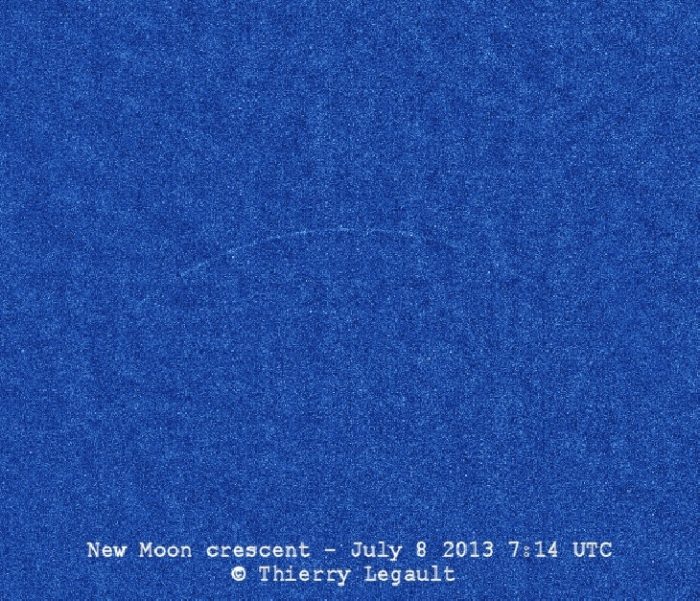

Youngest possible lunar crescent, with the moon’s age being exactly zero when this photo was taken — at the instant of new moon – 07:14 UTC on July 8, 2013. Image by Thierry Legault.
The next new moon falls on May 4, 2019, at 22:45 UTC; translate UTC to your time. This new moon is of interest to Muslims around the world because – in the days following it – the earliest sightings of a young crescent moon in the west after sunset will mark the start of the Islamic holy month of Ramadan.
Read more: When does Ramadan begin in 2019?
New moons can’t be seen, or at least they can’t without special equipment and a lot of moon-watching experience. The photo at the top of this post shows the moon at the instant it became new in July 2013. When the moon is new, it’s most nearly between the Earth and sun for any particular month. There’s a new moon about once a month, because the moon takes about a month to orbit Earth. The moon is nearly between the Earth and sun. In most months, there’s no eclipse because, most of the time, the new moon passes not in front of the sun, but simply near it in our sky.
Either way – in front of the sun or just near it – on the day of new moon, the moon travels across the sky with the sun during the day, hidden in the sun’s glare.
A day or two after each month’s new moon, a slim crescent moon always becomes visible in the west after sunset. In the language of astronomy, this slim crescent is called a young moon by astronomers. Will you see the May young moon after sunset on May 5? More about that in the next paragraph. The exact time of young moon (in this case 22:45 UTC on May 4, 2019) determines your young moon possibilities; it’s rare (but really fun and beautiful) to see a young moon less than 24 hours from new. That’s because the moon needs to be far enough from the sun on the sky’s dome for you to be able to see it. It needs time to move in orbit, to achieve that distance from the sun in our sky. The time of year makes a difference, too. The months around your spring equinox (March for the Northern Hemisphere, September for the Southern Hemisphere) provide your best chance to see your youngest moons.
The time of this month’s new moon – 22:45 UTC on May 4, 2019 – translates to 6:45 p.m. EDT on May 4. That’s the new moon instant for the east coast of the North America. The moon sets with the sun that day; you won’t see it from anywhere on Earth.
The next day – May 5, from, for example, New York City – the moon sets less than an hour after sunset. So you might see the May 5 young moon from New York (and from anywhere on the east coast of North America), but … wow. Tough observation. You would definitely need to be looking very shortly after sunset, at a very clear western horizon, and using some optical aid. East of there? Europe, Middle East, Africa? Very unlikely you’ll see the young moon May 5 with the eye alone, but telescopes and binoculars might pick it up. West of there? Western North America and islands in the Pacific? Your young moon chances on May 5 are better.
Most likely, for most of us around the world, we’ll see this month’s young moon with the eye alone beginning on May 6. From New York City, for example, on May 6 the moon sets about two hours after the sun.
New moons, and young moons, are fascinating to many. The Farmer’s Almanac, for example, still offers information on gardening by the moon. And many cultures have holidays based on moon phases.

Watch for the young moon to sweep past the planet Mars around May 6 to May 8, 2019. Read more.
Bottom line: New moon is May 4, 2019, at 22:45 UTC; translate UTC to your time.
Read more: Young moon and Mars after sunset May 6, 7, 8
Read more: 4 keys to understanding moon phases
Read more: EarthSky’s guide to the bright planets
Help EarthSky keep going! Please donate.
Source:
https://earthsky.org/moon-phases/new-moon